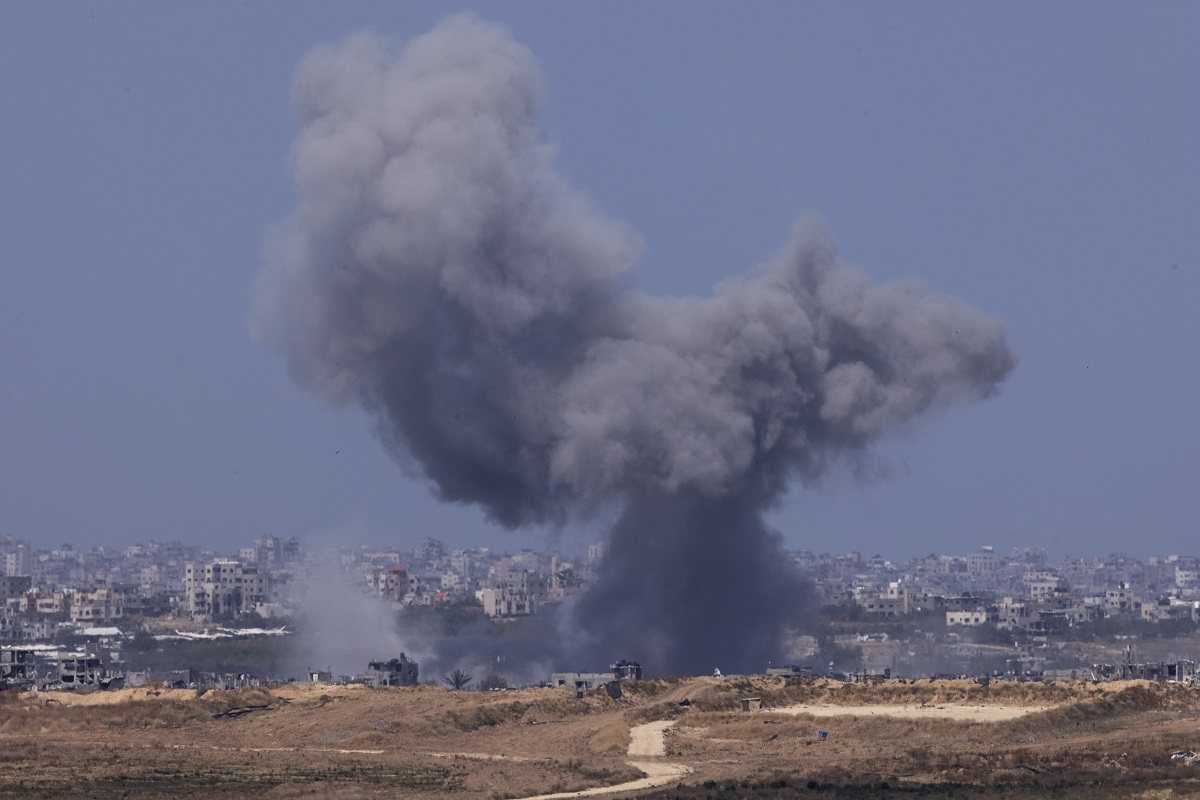
A plume from an explosion rises over northern Gaza, as seen from the Israel-Gaza border, amid renewed fighting on Sunday.
16:09 JST, May 13, 2024
JERUSALEM – Israeli forces continued to advance on the southern city of Rafah on Sunday and launched another operation against Hamas in the north, setting off a desperate scramble among war-weary civilians across Gaza. Humanitarian agencies warned that no place was safe and that essential aid had nearly run out, almost a week after Israel captured and shut down the border crossing with Egypt.
The expanding evacuations in Rafah, where Israel had ordered more than 1 million Palestinians to seek shelter from fighting early in the war, signaled a possible push into the heart of the city – a move that could prompt Washington, Israel’s staunchest ally, to freeze offensive weapons shipments after months of faltering cease-fire negotiations.
“We cannot, will not support an operation in Rafah, a major military operation, in the absence of a credible plan to protect civilians, and they [Israel] still haven’t delivered,” Secretary of State Antony Blinken told CBS’s “Face the Nation” on Sunday.
On a call between national security adviser Jake Sullivan and his Israeli counterpart, Tzachi Hanegbi, they discussed “alternative courses of action to ensure the defeat of Hamas everywhere in Gaza,” according to a White House readout. “Mr. Hanegbi confirmed that Israel is taking U.S. concerns into account,” the statement said.
But Prime Minister Benjamin Netanyahu has publicly brushed off President Biden’s warnings, arguing that Israeli forces must destroy Hamas’s remaining battalions in Rafah to eliminate the threat posed by the militant group after its deadly Oct. 7 attack on southern Israel.
Israeli officials concede that, in the absence of a viable postwar plan, Hamas has already been able to regroup in parts of the north that were cleared by the Israel Defense Forces last year – such as the Jabalya refugee camp, which the IDF shelled late Saturday, hours after issuing new evacuation orders.
The heavy bombardment sent 29-year-old lawyer Moamen al-Harthani and some 30 family members fleeing from their shelter in Jabalya, he told The Washington Post by phone Sunday. They made their way to western Gaza City, much of which has been reduced to ruins.
“People are living the same experience as before,” he said of the renewed fighting. Sunday’s flight marked his third displacement in seven months. He had nowhere to go, he said. The situation was “worse than the human mind can imagine.”
In a statement, the IDF said its troops operated overnight in Jabalya after airstrikes on about 30 Hamas targets – a rerun of a larger operation in November, when Israeli forces encircled the camp and claimed victory after weeks of intense combat with militants.
In the south, some 300,000 people have fled Rafah since the IDF first issued evacuation orders for the city on May 6, according to the U.N. Relief and Works Agency (UNRWA) for Palestinian refugees. Dozens of civilians have been killed in shelling there, according to Palestinian health officials.
More than 35,000 Palestinians have been killed in seven months of war, according to the Gaza Health Ministry, which does not distinguish between civilians and combatants but says the majority of the dead are women and children. The Israeli military says it has killed 13,000 fighters but has not provided supporting evidence.
IDF spokesman Daniel Hagari described the Rafah operation early Sunday as “precise” and “limited in scope,” saying that Israeli forces were avoiding the city’s “densely populated areas.” The IDF said Sunday that it had killed 10 Hamas militants in Rafah and dismantled a series of tunnel shafts.
The IDF operation had turned the city from an overcrowded place of last refuge into a dangerous ghost town, panicked Gazans told The Post.
Mawasi, a small coastal area in southern Gaza where Israel has directed civilians to flee, is ill-equipped to handle a new influx of families, according to relief agencies. The barren area on the outskirts of Khan Younis was already home to 400,000 people in tents, the United Nations estimated, and has been shelled repeatedly in recent months even though Israel deemed it a humanitarian zone.
“It’s chaotic,” said Ricardo Pires, a spokesperson for UNICEF, the U.N. children’s agency. “We have been warning for months that al-Mawasi is not a safe option. It is a narrow strip of beach on the coast that lacks the most basic infrastructure – like toilets and running water – needed to sustain the population.”
Mohammed al-Masry, 40, and his family had been sheltering at a school in Rafah after being driven from their home in the north. On Wednesday, they made the hours-long trek to Mawasi, mostly on foot, he told The Post by phone. Al-Masry, his wife and five children are now sharing a single tent.
“Everything is so expensive,” he said. “We are just trying to get by.”
In photos and videos shared by al-Masry, rows and rows of makeshift tents fill the flat, sandy area. There is no source of water or other humanitarian services nearby, he said.
A “full-blown famine” is already underway in the north and is spreading south, the World Food Program warned on May 5. A day later, Israeli forces seized the Rafah crossing, Gaza’s most vital entry point for aid and relief workers. With nothing allowed in for nearly a week, aid agencies say they are dangerously low on food and fuel.
“Operations on the ground are very stretched and highly unsafe for humanitarian workers,” Pires said. “We are running out of stock on whatever was pre-positioned before Rafah closed.
“We are trying to negotiate different crossings but no sign that any of it will work,” he added. “The needs are increasing significantly not only for Rafah but again in the north with new fighting in Jabalya.”
WFP spokesperson Alia Zaki told The Post that the agency has already been forced to reduce rations, and even those were “at risk of stopping in the next few days.”
Israeli authorities on Sunday announced the opening of a new “Western Erez” crossing into northern Gaza, though it can handle only a fraction of the traffic that flows through the southern crossings.
“Dozens of trucks of flour were coordinated from the Port of Ashdod on behalf of the WFP organization after undergoing security checks,” the IDF said in a statement.
The number of trucks entering the Palestinian territory is just a trickle of the roughly 500 that Israel allowed to enter before the war, according to the United Nations. Aid agencies say onerous Israeli restrictions and bombardments have crippled humanitarian efforts in Gaza.
The IDF on Sunday accused Hamas of firing rockets toward Kerem Shalom, another crossing in the south, “to prevent aid from reaching Gazans.”
"News Services" POPULAR ARTICLE
-

American Playwright Jeremy O. Harris Arrested in Japan on Alleged Drug Smuggling
-

Japan’s Nikkei Stock Average as JGB Yields, Yen Rise on Rate-Hike Bets
-

Japan’s Nikkei Stock Average Licks Wounds after Selloff Sparked by BOJ Hike Bets (UPDATE 1)
-

Japanese Bond Yields Zoom, Stocks Slide as Rate Hike Looms
-

Japan’s Nikkei Stock Average Buoyed by Stable Yen; SoftBank’s Slide Caps Gains (UPDATE 1)
JN ACCESS RANKING
-

Keidanren Chairman Yoshinobu Tsutsui Visits Kashiwazaki-Kariwa Nuclear Power Plant; Inspects New Emergency Safety System
-

Imports of Rare Earths from China Facing Delays, May Be Caused by Deterioration of Japan-China Relations
-

University of Tokyo Professor Discusses Japanese Economic Security in Interview Ahead of Forum
-

Japan Pulls out of Vietnam Nuclear Project, Complicating Hanoi’s Power Plans
-

Govt Aims to Expand NISA Program Lineup, Abolish Age Restriction



























